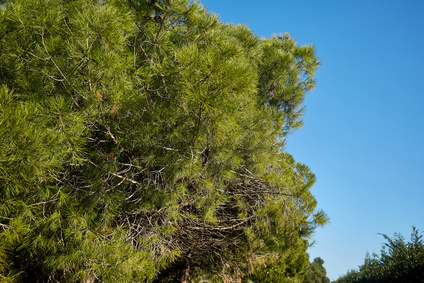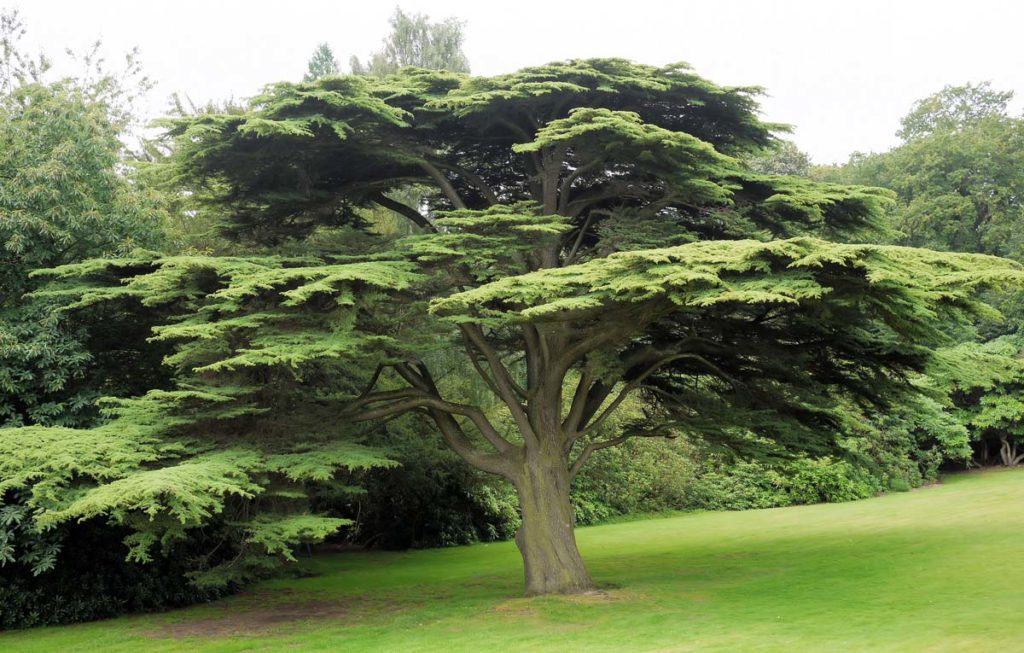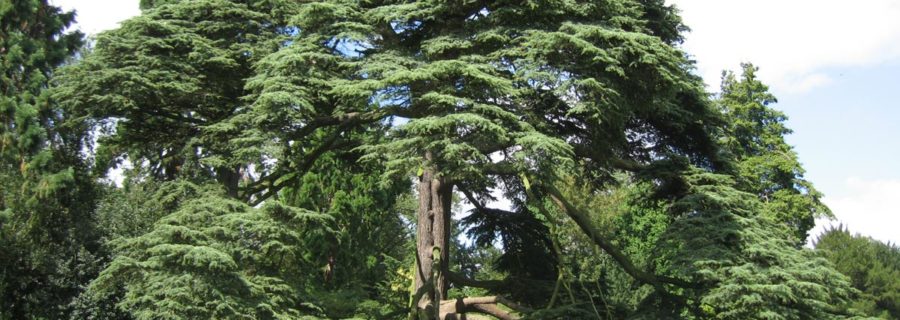How to Care for your Cedar Tree
It’s a beautiful, eye catching tree, but the cedar really does need a good amount of attention, and there are certain rules to follow when pruning. Read on for the advice you need to take care of your cedar tree.
Cedar trees, of the Latin Cedrus Libani, are evergreen conifers. A member of the pine family, cedars are native to the Lebanon, eastern parts of the Mediterranean and parts of Asia. They are also very popular across the UK.
Cedar trees grow to around 35 metres in height with a spread of more than 8 metres. They are known for their natural insect repellent timber as well as their multiple trunks and distinctive horizontal layers.


The cedar tree is a very popular architectural tree thanks to its eye-catching appearance. It is also a low maintenance tree, making it a popular choice for public grounds and attractions.
Why prune a cedar tree?
For the most part the cedar tree requires at most very little pruning. In actual fact, most tree experts will suggest leaving the cedar tree well alone. As long as it has been planted in a setting with ample space, no issues should arise with crowding other plants, or interfering with buildings.
Sometimes though situations do arise when cedar trees need pruning. They may have been planted too close together or too close to other plants for example, or there may be damaged branches following a storm, or dead wood that needs removing. It is vital to be aware that when pruning a cedar tree, exceptional care is needed. Let’s take a look at why this is.
Why you need to proceed with caution when pruning a cedar tree
The cedar tree does not lend itself to pruning of any form. Prune too deeply into the branches, and the tree could reach an untimely end. Here’s why this is.
Within the middle section of the canopy of a cedar tree there is a ‘dead zone’. New growth is incredibly dense. It blocks the sunlight from the older growth and without light, the older growth quickly dies. The new outer growth of a cedar tree does not extend very deep into the tree, which makes it easy to inadvertently cut right back into the dead zone. Do this and the branches will not regrow.
For this reason we highly recommend calling in professional tree surgeons to take care of any necessary cedar tree pruning. It could literally mark the difference between the life and death of your cedar tree.

When to prune a cedar tree?
The general rule of thumb is that you should not prune a cedar tree too often. Yes, the cedar tree is ornamental, which for many people means it needs pruning during its early years to promote an attractive shape and strong framework. This however is absolutely not the case with the cedar tree. Its distinctive shape occurs through natural, unattended growth.
As we already mentioned however, from time to time a need will arise for cedar tree pruning. Some cedar trees for example develop two leaders in their early years. Trees with two leaders end up with twin trunks, making them less sturdy and more susceptible to storm damage. A single, thicker trunk is much more desirable, so removing the weaker leader early on is good practice. Early spring is the optimum time to carry out this task.
Cedar tree pruning may also be required in order to remove damaged or dead branches. This is usually an urgent requirement, so can be done at any time of the year. Do be careful though not to disturb nesting birds and only carry out work that is completely necessary outside of the tree’s dormant period which is late winter to early spring.
Sometimes a cedar tree will extend beyond the boundary you had in mind. It may therefore be necessary to prune it accordingly. This must however be approached with exceptional caution and a very particular process so as not to prune into the dead zone.
Pruning to maintain size and shape should be carried out on a branch by branch basis, and only during the tree’s dormant period, again late winter to early spring.
How to prune your cedar tree?
The first thing to do before you prune your cedar tree is to take a step back and work out what needs to be done to create a beautiful looking, balanced tree.
Always work with the natural flow of the tree; to go against it will produce a look that lacks elegance.
Kit yourself out with protective gloves and head and eye protection, and some good quality, sharp cutting tools.
The first job is to remove diseased, damaged or dead shoots and then focus on the ones that are weak or rubbing together.
Next you can move on to larger branches and limbs.
Make your cut just above a healthy bud, a pair of buds or a side shoot. If possible, cut towards an outward facing bud or branch. This will avoid congestion and branch rubbing. The cut should be made around a quarter of an inch or half a centimetre above the bud. Avoid cutting too close to the bud as this is likely to kill it. Cut too far from the bud however and you could see dieback of the stub, and disease could take hold.
For larger limbs, make an undercut around eight inches to a foot or 20-30 centimetres from the trunk, then follow with an overcut. This prevents tearing of the bark and leaves a nice clean stub. To remove the stub, start with an undercut just outside the collar of the branch (the swelling where the branch joins the trunk), and then make an overcut to meet the undercut. Angling the cut away from the trunk will produce a slope that allows rain to drain off. Cutting flush to the trunk is to be avoided as this will damage the collar which is a vital protective zone for the tree and where healing takes place.
Wound paints aren’t needed when pruning a cedar tree. If the wounds bleed sap then refrain from bandaging or binding the cut. This could hinder rather than boost healing.
Always remember to thoroughly clean your cutting tools if you have used them to prune out disease. Use a disinfectant to prevent the spread of disease to other shoots or plants.
You are best to prune during dry weather. This also minimises the spread of disease. Be sure to bag up waste material and dispose of it responsibly. Never keep diseased logs; only the healthy ones should be kept if you want to create wildlife habitats.

Cedar tree care tips
It is good practice to maintain a two-inch layer of mulch around a cedar tree, although you should not allow this to touch the trunk. This will prevent moisture loss and protect the tree.
A wire cage will prevent injury from mowers and will also ward off wildlife that is partial to the tasty bark. Young trees may benefit from an insulating cover during particularly cold winter spells.
Smaller cedar trees should be watered regularly, always allowing the soil to dry out completely between each watering. Fertiliser is not usually necessary unless the soil is particularly lacking in nutrients.
Mature cedar trees need little more than regular mulching and removal of dead or diseased branches.
Cedar trees are not susceptible to as many diseases as other trees, but pests can prove an issue. Aphids, the cypress tip moth, the root weevil, mites and juniper scale are all typically attracted to the cedar tree. If infestation becomes excessive, it may be necessary to treat the tree with some form of insecticide. Professional advice is wise in this case.
Honey fungus may also cause problems. Be on the lookout for decaying roots, white fungus between the wood and the bark, and rhizomorphs which are usually a sign of this disease.
Expert help in caring for your cedar tree
The risks associated with cedar tree pruning cannot be over-emphasised. If you value your cedar tree then we highly recommend that you invest wisely in professional expertise.
A qualified tree surgeon will know precisely how and when to prune your cedar tree. They will safely remove any dead wood without damaging the tree, and will know what to look for in terms of disease, pest infestation and decay and will treat any issues in a timely fashion so that the tree has the best possible chance of survival.
If you have a cedar tree on your land that could do with some expert care and attention, why not contact TH Trees Ltd? As fully qualified and long term experienced tree surgeons with verifiable references and local authority and Trading Standards approval, we are in a position to offer specialist knowledge and expertise in all aspects of cedar tree care and pruning. For a free, no-obligation quotation, give us a call on 01268 642814 or get in touch here.
Amazing service from Mark and his team. We had a problem with Bamboo that had spread from a neighbours garden. Mark kept us informed with regular phone calls and images of how the work was progressing, as we were not present the house. 1st class job and a pleasure to do business with this company.
Thank you Colin and Gillian for your kind review. It was a pleasure to be able to clear the bamboo for you.







